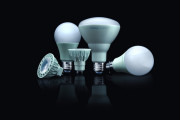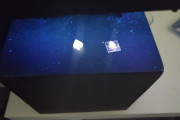 2024-08-05
2024-08-05
What is blue light? The effect blue light has on your sleep and more.
Although it is environmentally friendly, blue light can affect your sleep and potentially cause disease. Until the advent of artificial lighting, the sun was the major source of lighting, and people spent their evenings in (relative) darkness. Now, in much of the world, evenings are illuminated, and we take our easy access to all those lumens pretty much for granted.
But we may be paying a price for basking in all that light. At night, light throws the body's biological clock—the circadian rhythm—...
Continue reading →
 2019-12-19
2019-12-19
Researchers at The University of Manchester in the UK discovered that blue light may not be as disruptive to our sleep patterns as originally thought. According to the team, using dim, cooler, lights in the evening and bright warmer lights in the day may be more beneficial to our health. The scientists claimed that twilight is both dimmer and bluer than daylight and the body clock uses both of those features to determine the appropriate times to be asleep and awake. In the research on mice, the team used a specially designed lighting whose color can be adjusted without changin...
Continue reading →
 2019-12-12
2019-12-12
Lighting Research Center (LRC) continues to conduct studies to learn how light impacts alertness during the day and sleep quality at night in daytime office workers. In its latest press release, LRC revealed that using blue light in the morning and red light in the afternoon helps office to increase energy.
The study field tested a novel luminaire developed by the LRC to promote circadian entrainment and alertness in the office environment. 19 participants from three U.S. Department of State office buildings in Washington, D.C., completed the 3-week study.
During ...
Continue reading →
 2019-05-24
2019-05-24
Scientists warned that intensive exposure of blue light through heavy usage of electronical devices such as mobile phones and tablets might affect sleeping quality. A new study showed that by limiting or blocking evening exposure to light-emitting screen for one week, sleep quality for teenagers can be improved.
The collaborative study by the Netherlands Institute of Neuroscience, the Amsterdam UMC and the Dutch National Institute for Public Health and the Environment indicates that by simply limiting exposure to blue-light emitting devices in the evening, adolescents can ...
Continue reading →
 2019-05-06
2019-05-06
Researchers at West Virginia University found that exposure to white light at night could impact recovery of cardiac patients and dimming the light can reduce the damages. With the results published in Experimental Neurology, the research team, led by Randy Nelson, who chairs the Department of Neuroscience in the WVU School of Medicine, linked white light at night to inflammation, brain-cell death and higher mortality risk in cardiac patients. (Image: Pixaby) The researchers re-created cardiac arrest in animal models and divided the models into three groups that w...
Continue reading →
 2019-04-09
2019-04-09
The love-hate relationship between human and blue light becomes more complicated with a new research published by researchers at Purdue University and Boston University. They discovered that blue light exposure can kill Methicillin-resistant Staphylococcus aureus (MRSA), a bacterium that causes infection in various parts of the body and is called “superbug.”
(image: Pixabay)
According to the new research, published on March 30, 2019 on Advanced Science, researchers found that exposing MRSA to blue light can render it defenseless against antiseptics as m...
Continue reading →
 2019-04-08
2019-04-08
Soraa, founded by Shuji Nakamura, the Nobel Prize winner, announced a new series of blue light free LED lamp with its patented technology for enhancing health and well-being.
(Image: Soraa)
The new product, Soraa HEALTHY, with the featured ZEROBLUE technology, emits a blue-free spectrum which reduces melanopic lumens about 40 percent compared to conventional LEDs. According to Soraa, the HEALTHY combine an engineered mix of green and red phosphors to produce a spectrum with a wide gap in the blue range, removing blue completely while retaining a h...
Continue reading →
 2018-10-30
2018-10-30
Recently, the topic of blue light harming the eyes has been taken seriously and new LED development has focused on reducing the negative effect of blue light on the body. Theoretically, blue light wavelength ranges from 420nm to 480nm. According to one of the reports done by International Electrotechnical Commission (IEC), the shorter wavelength range of blue light from 415nm to 460nm is most likely to damage the eye. The report also mentioned that when exposed to these short blue light ranges, the risk of getting eye disease such as Macular degeneration will increase.
Most...
Continue reading →
 2018-10-15
2018-10-15
A Spanish research team has developed a new light emitting material which generates light source that is similar to the sun and reduces the harmfulness of blue light. The result was published in Materials Horizons in September 2018.
Continue reading →
 2018-04-30
2018-04-30
The “blue light” emitted by street lights including LEDs, and commercial outdoor lighting such as advertising, is linked to a significant increase in the risk of breast and prostate cancer, innovative new research has concluded.
Continue reading →
 2016-09-22
2016-09-22
The Lighting Research Center (LRC) at Rensselaer Polytechnic Institute is recruiting subjects 18-30 years old to participate in a paid study that will take place on four consecutive Fridays: September 30, October 7, October 14, and October 21. The goal of the study is to test the effects of light from Apple iPad screens on melatonin production.
Continue reading →
2016-05-19
Exposure to bright light could affect your metabolism, reports a new Northwestern Medicine study.
Continue reading →
2015-11-10
Philips introduced two new smartphones that employs its Soft Blue technology to reduce eye strain in October 31, 2015 in China, according to an article from Vine Report.
Continue reading →
 2015-05-14
2015-05-14
Blue light is important for the body to regulate the circadian rhythm, but too much exposure can cause permanent damage to the eyes, reported Pocono Record.
Continue reading →
 2014-11-04
2014-11-04
We live in a non-stop world where most of us are sleeping less than previous generations. The ready availability of artificial light has made it easy to work and socialize around the clock – leading many health professionals to question the impact this increased exposure is having on our wellbeing.
Continue reading →
 2014-05-27
2014-05-27
It was 1958, when J. Woodland Hasting and Beatrice M. Sweeney wrote the paper entitled "A persistent diurnal rhythm of luminescence in gonyaulax polydra". Paper concluded on how lights of different wavelength have the ability to change flow of a hormone named melatonin and hence affecting human body clock, also known as circadian rhythm (as shown in Fig 1).The most powerful wavelength to do so was found to be that of blue.
Continue reading →
2014-05-16
BenQ announced the offering of its new Eye-care Series monitors as a permanent addition to its monitor product line, stressing on its commitment to safeguard eye vision and to always act first on offering the most comfortable and enjoyable viewing experience to users around the world – because eye health matters. Developed based on the findings of extensive eye-care research and in-depth consumer focus groups, the Eye-care Series monitors feature BenQ’s exclusive Flicker-free technology and four Low Blue Light Modes for office, web-surfing, multimedia and reading use, meeting the day-to-day needs of heavy computer users who are concerned about eyestrain, as well as notebook users who are seeking to extend their flickering small-size notebook screen onto a bigger, Flicker-free screen.
Continue reading →
2014-03-11
U.S. cities are overhauling old lighting systems with energy efficient LED streetlights, as the energy efficient lights are much brighter than conventional lights, energy efficient and provide higher cost-saving capacity. However, blue-rich LED lights can disrupt the circardian rhythm of humans, animals, and even plants according to an article by Earth Island Journal.
Continue reading →
2014-01-02
With LED lighting demands rapidly growing, questions regarding safety and whether blue light found in LEDs can affect health are being discussed now more than ever. Affects on health that are the heart of discussion within the industry include whether long term exposure can affect the release of melatonin and if looking directly at blue light can lead to degeneration of retinal tissue.
Continue reading →
 2024-08-05
2024-08-05
 2019-12-12
2019-12-12
 2019-05-24
2019-05-24
 2019-05-06
2019-05-06
 2019-04-09
2019-04-09
 2019-04-08
2019-04-08
 2018-10-30
2018-10-30
 2018-10-15
2018-10-15
 2018-04-30
2018-04-30
 2016-09-22
2016-09-22
 2015-05-14
2015-05-14
 2014-11-04
2014-11-04
 2014-05-27
2014-05-27